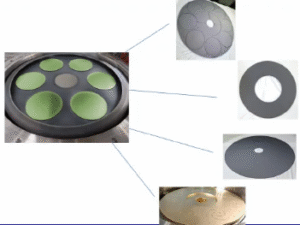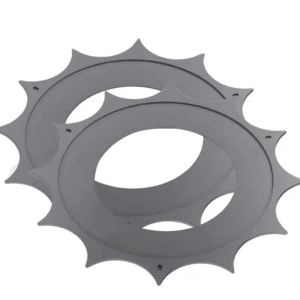カーボンファイバーコンポジット(C/C)は、現代の産業を変革した画期的な材料を表しています。 これらのコンポジットは、優れた強度を軽量構造と組み合わせ、高性能な用途に欠かせない製品です。 彼らの汎用性は、航空宇宙、自動車、産業分野を横断し、耐久性と効率性がパラマウントされています。 寧波VETエネルギー技術有限公司は、化学蒸気蒸着やトーレカーボンファイバーT700の使用など、高度な製造技術を統合することにより、このイノベーションを高め、優れた品質と信頼性を保証します。 これらの材料のグローバル需要が高まるにつれて、技術と持続可能性の進歩における役割はますますます顕著になります.

要点
- カーボンファイバーコンポジット(C/C)は、航空宇宙および自動車産業における高性能な用途に理想的な、優れた強度から重量比を提供します.
- これらのコンポジットは驚くべき熱抵抗および化学耐久性を展示し、極端な環境での信頼性を確保し、メンテナンスコストを削減します.
- 自動繊維の配置および化学蒸気の沈殿物のような高度の製造業の技術は、カーボン繊維の合成物の質そして性能を高めます.
- C/C/Cの軽量化により、航空機や車両の燃費効率が大幅に向上し、炭素排出量を削減することにより、持続可能性の目標に貢献します.
- 再生可能エネルギーや医療技術などの産業は、C/Cのユニークな特性から恩恵を受けており、風力タービンブレードや専門機器の革新につながります.
- カーボンファイバーコンポジットの初期費用は従来の材料よりも高くなりますが、その長期耐久性と性能は、大幅なコスト削減をもたらします.
- カーボンファイバーコンポジットは、さまざまな分野における炭素繊維コンポジットの普及が進んでおり、生産技術の進歩と、その利点の認識が高まっています.
カーボン繊維の合成物(C/C)の技術仕様
材料特性
強さに重量の比率
カーボンファイバーコンポジット(C/C)は、優れた強度から重量比を発揮し、高い性能を必要とする業界に好まれた材料を発揮します。 軽量構造を維持しながら、優れた機械的強度を実現します。 このユニークなプロパティにより、エンジニアは耐久性を損なうことなく、全体的な重量を減らすコンポーネントを設計することができます。 航空機や自動車製造などの用途は、燃料効率と性能を高めるため、この機能から大幅に向上します.
熱伝導性および熱抵抗
カーボンファイバーコンポジット(C/C)の熱伝導率は、1150°Cの10~30W/m.kの範囲で、極端な環境での効率的な熱管理を実現します。 これらの複合材料は、2400°Cを超える加工温度に耐える、驚くべき耐熱性を示しています。 このような特性は、金属と非金属の溶融を含む高温用途に不可欠です。 熱応力の下で構造的な完全性を維持する能力は要求する産業プロセスの信頼性を保障します.
化学抵抗および耐久性
カーボン繊維の合成物(C/C)は化学腐食に抵抗し、粗い環境の長期耐久性を保障します。 従来の材料とは異なり、これらの複合体は積極的な化学物質や極端な条件にさらされても性能を維持します。 このレジリエンスは、材料が機械的および環境的課題の両方に耐える必要がある航空宇宙などの産業のアプリケーションに適しています.
Performance Metrics
抗張および圧縮強さ
炭素繊維コンポジット(C/C)の引張強さは90〜130MPaの範囲で、圧縮強度は130〜170MPaの範囲です。 これらのメトリクスは、変形や故障なしで重要な力に耐える能力を強調しています。 航空機および高性能車の構造部品のような高い機械性能を要求する適用の信頼性を、保障します.
バルク密度および処理温度
1.40 から 1.50 g/cm3 のバルク密度を使って、カーボン繊維の合成物(C/C)はさまざまな適用のためのライト級選手けれども強い解決を提供します。 重大化システムにおける軽量化に貢献し、効率性を高めます。 また、その高い処理温度能力は、航空宇宙や冶金的なプロセスで遭遇するような極端な産業条件の適合性を保証します.
Comparison with Other Materials
炭素繊維対鋼
鋼鉄と比較されて、カーボン繊維の合成物(C/C)はかなり高い強さに重量の比率を提供します。 鋼は、強度が強い一方、構造物にかなりの重みを追加し、重量削減が重要であるアプリケーションの使用を制限します。 一方、炭素繊維は、はるかに少ない重量で同等の強度を提供し、航空宇宙や自動車などの業界に最適です。 さらに、炭素繊維は、鋼よりも腐食に抵抗し、メンテナンスコストを削減します.
カーボン繊維対アルミニウム
アルミは軽量性で知られていますが、カーボンファイバーコンポジット(C/C)は強度と耐久性を両立しています。 アルミニウムは高い圧力の下で変形しますが、カーボン繊維は要求する適用の信頼性を保障する構造の完全性を維持します。 また、炭素繊維は、アルミニウムと比較して高温環境に適した優れた熱抵抗を発揮します.
炭素繊維複合材(C/C)の製造工程

カーボンファイバーコンポジット(C/C)の製造プロセスは、精度と高度な技術と優れた特性を達成します。 各方法は特定の産業条件に食料調達する独特な利点に貢献します。 以下は、これらの複合材料の製造に使用される重要なプロセスです.
手のレイアウト
ハンドレイアッププロセスは、カーボンファイバーコンポジット(C/C)を製造するための最も伝統的な方法の1つです。 テクニシャンは、カーボンファイバー生地の層を金型に手動で配置し、適切なアライメントとオリエンテーションを保証します。 樹脂は繊維を一緒に結合するために、そして制御された条件の下で治ることによって加えられます。 複雑な形状や試作の製作に最適です。 労働力に富んだ自然にもかかわらず、手持ちのレイアウトは、柔軟性と費用効果の高いため、小規模な生産に適しています.
歴史の洞察: : : カーボン繊維の生産の跡の根はへ戻ります 1960s, ハンドレイアップのような初期の方法は、材料の初期アプリケーションをシェーピングする際にピボタルだったとき. 現代の進歩の基盤を築き上げた技術.
自動繊維の配置(AFP)
自動繊維の配置(AFP)はオートメーションおよび精密を導入することによってカーボン繊維の合成物(C/C)の製造業に革命を起こします。 このプロセスは、ロボットシステムを使用して、カーボンファイバーテープを敷くか、特殊な精度で金型にねじ込みます。 配置角度、張力、速度を制御し、大規模生産の一貫した品質を保証します。 AFPは、材料の廃棄物と生産時間をを大幅に削減し、航空宇宙や自動車などの産業に適しています.
- AFPの利点:
- 高い生産の速度.
- 最小材料の耐圧.
- 大規模な製造における優れた一貫性.
AFPの紹介 1970年代 カーボン繊維技術の転換点をマークしました。 まで 95%カーボンコンテンツ 繊維では、この時代は、高性能用途における炭素繊維の急速な採用を目撃しました.
Resin Transfer Molding (RTM)
樹脂トランスファー成形(RTM)は、カーボンファイバーコンポジット(C/C)の構造的完全性を高めるクローズドモールドプロセスを提供します。 この方法では、炭素繊維プレフォームは金型内に設置され、樹脂は繊維を阻害する圧力下で注入されます。 金型は、合成を治すために加熱され、優れた表面品質と機械的特性で完成品になります。 RTM は、特に軽量で耐久性のあるコンポーネントを必要とする産業で、中型から高音量部品までの製造に広く使用されています.
- RTMの主な特長:
- 高品質の表面仕上げ.
- 均一樹脂分布.
- 複雑な幾何学との互換性.
風力タービンやロボットなどの分野における炭素繊維の需要が高まっています。そこで、精密・強度がパラマウントされています.
お問い合わせ: 「高性能炭素繊維の生産は、炭化し、そのユーティリティを広大なアプリケーションに拡大するまで、レインの加熱鎖を含みます。」 この原則は、RTMや他の高度な技術の成功を支持します.
Ningbo VETによる高度な技術 エネルギー
化学蒸気蒸着炉蒸着
ニンポー VET エネルギーはカーボン繊維の合成物(C/C)の質そして性能を高めるために化学蒸気の沈殿物(CVD)の炉の沈殿物を採用します。 この高度な技術は、ガス反応剤を高温炉に導入し、炭素繊維基質に固体材料を分解し、堆肥化させます。 プロセスは均一コーティングを保障し、合成物の特性上の精密な制御を、熱伝導性および構造完全性のような保障します.
CVD炉の沈着は98.5%から99.9%に造る高炭素分を達成するpivotal役割を担います、それはNingbo VETのエネルギーの合成の優秀な質を定義します。 この方法は、材料の極端な温度や化学暴露に対する抵抗を増強し、要求産業用途に適しています。 このプロセスの細やかな性質は、高機能材料を必要とする業界のための信頼性と耐久性のあるソリューションを提供するために、同社のコミットメントを反映しています.
歴史の洞察: : : 高性能炭素繊維の開発が始まりました 1960s、それらを炭化するために熱するrayonの鎖のような革新を使って。 これらの初期の進歩は、CVDなどの近代的な技術のための地理を築き、今では優れた特性を持つ複合材料の生産を可能にしました.
東レカーボン繊維のT700および3D針の編むことの使用
ニンポー VET エネルギーはトーレカーボン繊維T700をその製造プロセスに統合し、比類のない強度と信頼性を保証します。 Toray T700繊維は、高張力と軽量特性で有名で、カーボンファイバーコンポジット(C/C)の製造に理想的な選択肢となっています。 これらの繊維は、そのアライメントとパフォーマンスを最適化するために厳格な事前織手順を受けています.
会社は3D針の編むことによって合成物の構造の完全性を高めます。 この革新的な技術は、炭素繊維を3次元に連結し、堅牢で凝集的な構造を作り出しています。 3D針編みプロセスは、剥離リスクを最小限に抑え、コンポジットの機械的特性を改善し、高強度条件下での耐久性を保証します.
東レT700繊維と3D針編みのこの組み合わせにより、ニンポーVETエネルギーは、優れた強度から重量比と優れた熱抵抗で複合体を製造することができます。 これらの特徴は、性能と信頼性が重要である航空宇宙、自動車、冶金学などの業界で欠かせない製品です.
お問い合わせ: 「強いけれども軽量カーボンファイバーの天体的上昇が始まりました 1970年代、最大95%カーボンを含む繊維の導入で。 ニンポー VET エネルギーは、最先端の材料と技術を応用し、炭素繊維複合材料の境界線をプッシュすることで、この遺産に構築されています.
カーボン繊維の合成物(C/C)の適用
航空宇宙産業
航空機構造で使用する
航空宇宙産業は大きく依存しています 炭素繊維複合材料(C/C) 重要な航空機コンポーネントの構築 これらのコンポジットは、比類のない強度から重量比まで、軽量で堅牢な構造の生産を可能にします。 航空機メーカーは、胴体、羽根、尾のセクションでそれらを使用し、全体的な重量を削減しながら、構造の完全性を高めます。 航空機の性能に直接影響し、より高いペイロード容量を可能にし、操縦性を改善しました。 極端な機械的ストレスと環境条件に耐えるこれらの複合体の能力は、航空用途における信頼性を保証します.
燃料効率の利点
燃料効率は航空宇宙工学の最優先事項です。 軽量の性質 炭素繊維複合材料(C/C) フライトに必要なエネルギーを大幅に削減します。 航空機重量が低いため、操業コストを削減するだけでなく、炭素排出量を最小限に抑える燃料消費を削減します。 これにより、これらの複合材料は、現代の航空における持続可能性の目標を達成するために不可欠です。 3Dのオトゴナル糸の建築のような高度の製造業の技術の統合によって、ニンポーVETエネルギー技術Co.、株式会社のような会社はこれらの複合体の熱そして機械特性をさらに最大限活用し、高力環境の優秀な性能を保障します.
自動車産業
性能車両の軽量化
自動車分野において、, 炭素繊維複合材料(C/C) 車両性能向上に重要な役割を果たします。 高性能車は、加速、処理、ブレーキの効率性を向上させるこれらの複合体の軽量特性から恩恵を受けます。 メーカーは、シャーシ、ボディパネル、サスペンションコンポーネントに組み込まれ、最適な重量分布と構造剛性を実現します。 4-Dの対角の合成ヤーンの建築のような高度の技術の使用は、性能車の特定の必要性に食料調達する機械特性の精密なカスタム化を可能にします.
電気自動車の役割(EV)
電動車(EV)は、バッテリーの効率を最大化し、運転範囲を拡張する軽量材料を要求します. 炭素繊維複合材料(C/C) 不必要な重量を加えないで例外的な強さを提供することによってこの条件を満たして下さい。 EVメーカーは、バッテリーエンクロージャ、構造フレーム、エアロダイナミクスコンポーネントのこれらのコンポジットを活用してエネルギー効率を高めています。 また、これらのコンポジットの高い熱伝導性により、電池の性能と安全性を維持するために重要な効果的な熱放散を保証します。 寧波VETエネルギー技術有限公司は、化学蒸気浸入(CVI)の専門知識は、EV市場でそれらを不可欠にする、これらの材料の耐久性と信頼性を高めます.
Industrial Applications
金属および非金属の溶けること
金属および非金属の溶けるプロセスに関与する企業は独特な特性から非常に寄与します 炭素繊維複合材料(C/C). . 2400°Cを超える温度に耐える優れた熱抵抗を発揮します。 高い熱伝導性により、効率的な熱伝達を確保し、グラファイトの可燃物、金型、プレートの使用に最適です。 ニンポーVET Energy Technology Co., Ltd.は、優れた炭素含有量と構造的完全性を有する複合材料を製造するために、化学蒸気蒸着(CVD)などの高度な製造技術を活用しています。 高温産業環境での信頼性の高い性能を保証します.
高温環境
性能を損なうことなく極端な条件に耐えることができる高温産業用途要求材料. 炭素繊維複合材料(C/C) 顕著な熱抵抗および化学安定性によるそのような環境のExcel。 炉ライニング、熱交換器、その他重要な成分の複合材を強烈な熱応力を発揮します。 糸のアーキテクチャをカスタマイズする能力は、4D機内構成など、メーカーは、これらの複合材料の熱的および機械的特性を特定の用途に調整することができます。 この適応性は、要求産業設定の最適な性能と長寿を保証します.
その他の産業
再生可能エネルギー(風力タービンブレードなど)
再生可能エネルギー分野はますますます増加しています 炭素繊維複合材料(C/C) 風力タービンの刃の効率そして耐久性を高めるため。 これらのコンポジットは、軽量性と優れた強度のユニークな組み合わせを提供し、長くより効率的なブレードの生産を可能にします。 より長い刃は風力エネルギーを捕獲し、風力タービンの全体的な出力を著しく改善します。 これらのコンポジットの高い剛性は、ブレードの変形を強風条件下で最小限に抑え、安定した性能と信頼性を保証します.
機械的利点に加えて、, 炭素繊維複合材料(C/C) 湿気、紫外線放射および温度の変動のような環境要因への優秀な抵抗を提供します。 風力タービンブレードの動作寿命を延ばし、メンテナンスコストとダウンタイムを削減します。 ニンポーVETのエネルギー技術Co.、株式会社は最大限に活用された熱および機械特性の複合体を作り出すために化学薬品の蒸気のろ過(CVI)を含む高度の製造業の技術を利用します。 これらのイノベーションは、材料が再生可能エネルギーアプリケーションの厳格な要求を満たし、持続可能なエネルギーソリューションへのグローバルな移行に貢献することを保証します.
事実: : : 風力タービンブレードのカーボンファイバーの採用により、高風速の活用に欠かせない、より大きな耐久性のあるブレードが、沖合いの風力ファームの開発を可能にしました.
医療機器および専門医
医学の企業はの適用からかなり利点します 炭素繊維複合材料(C/C) 装置および専門医。 これらのコンポジットは、比類のない強度から重量比の比を提供し、軽量で耐久性のある義肢を作成するのに理想的です。 患者は、これらの義肢の自然な動きを密接に模倣するこれらの義肢の体重減少による運動と快適さを改善しました。 素材の高張力は、長期間にわたる信頼性を提供する、日々の摩耗や涙に耐えることができることを保証します.
医療機器では、, 炭素繊維複合材料(C/C) 高度の診断および外科用具の開発に貢献して下さい。 それらの生体適合性および腐食に対する耐性は、インプラントやその他の医療用途で使用するのに適しています。 ニンポーVET Energy Technology Co., Ltd.は、3Dオトゴナルや4D機内構成などの糸アーキテクチャの専門知識を活用して、特定の医療ニーズにこれらの複合材料の特性をカスタマイズします。 この適応性は、患者の成果を高め、医療機器の機能を向上させる、カスタマイズされたソリューションの作成を可能にします.
お問い合わせ: 「医療技術の炭素繊維コンポジットの統合は、比類のない性能と忍耐強い満足を提供する専門性とデバイスの設計に革命を起こしています。 ツイート
カーボンファイバーコンポジット(C/C)のコスト検討

要因の影響 コスト
原料価格
原料の費用はカーボン繊維の合成物(C/C)の作成の全体的な費用に著しく影響を与えます。 東レT700などの高品位カーボン繊維は、優れた強度と耐久性を実現するために不可欠です。 これらの繊維は、その優れた価格設定に貢献し、複雑な製造プロセスを受けています。 また、繊維を結合するために使用される樹脂システムは材料費に加えます。 大気および宇宙空間および自動車のような企業のカーボン繊維の材料のための全体的な要求は原料の価格に、頻繁に費用の変動に導く影響します.
製造の複雑さ
カーボンファイバーコンポジット(C/C)の生産に関わる複雑なプロセスもコストを引き上げます。 化学蒸気蒸着(CVD)や樹脂転写成形(RTM)などの技術は、先進的な機械・熟練工を必要としています。 例えば、ニンポーVET エネルギーは3D針の編むことおよびCVDの炉の沈着を採用し、それらの複合体の構造完全性そして熱特性を高めます。 これらの方法は、高品質の出力を保証しますが、生産費を増加させます。 繊維を揃え、樹脂の分布を制御するために必要な精度は、複雑さの別の層を追加し、製造プロセスをタイムインテンシブとコストリーにします.
コスト対パフォーマンストレードオフ
品質と手頃な価格のバランス
素材を選択する際には、品質と手頃な価格のバランスをとっていなければなりません。 カーボンファイバーコンポジット(C/C)は、比類のない強度と熱抵抗を提供し、高性能な用途に優れた選択肢を提供します。 しかし、鋼やアルミニウムなどの伝統的な材料と比較して、より高いコストは課題を提起することができます。 メーカーは、多くの場合、投資を正当化炭素繊維の利点を決定するために、プロジェクトの特定の要件を評価します。 例えば、航空宇宙および自動車分野において、これらの複合体の軽量性は、燃費の効率性を高め、排出量を削減し、初期費用を削減します.
耐久性による長期コスト削減
カーボン繊維の合成物(C/C)の耐久性は重要な長期費用節約を提供します。 これらの材料は腐食、摩耗および極度な温度に抵抗しま、維持および取り替えの費用を時間上の削減します。 風力タービンブレードが過酷な環境条件に耐える再生可能エネルギーのような産業では、炭素繊維複合材の長寿は、操業上の混乱を最小限に抑えます。 同様に、電気自動車の使用は、バッテリーの効率を高め、構造コンポーネントの寿命を延ばし、より高いコストにもかかわらず、投資に対する有利なリターンを提供します.
市場動向
費用効果が大きい生産の進歩
カーボンファイバーコンポジット(C/C)の生産コストを削減することを目的とした製造技術の最近の進歩。 自動化された繊維の配置(AFP)および樹脂システムの革新のような自動化されたプロセスは材料の無駄および労働条件を下げる合理化された生産を備えています。 研究者はまた、炭素繊維をよりアクセス可能にする代替原料とリサイクル方法を検討しています。 これらの開発により、業界は性能を損なうことなく、または予算の制約を超える炭素繊維コンポジットを採用することができます.
業界の採用拡大
カーボンファイバーコンポジット(C/C)の採用は、優れた特性により、さまざまな産業で成長し続けています。 航空宇宙および自動車分野は、軽量化と性能向上のためにこれらの材料を活用し、最大の消費者を維持します。 再生可能エネルギー部門は、特に風力タービンブレード製造において、炭素繊維の強度と耐久性にも優れています。 生産コストが減少し、その利点の認識が増加するにつれて、より多くの産業は、炭素繊維複合体をその操作に統合し、さらなる革新と市場拡大を促進することが期待されています.
カーボンファイバーコンポジット(C/C)は、比類のない強度から重量比、熱安定性、耐薬品性を提供する画期的な材料として際立っています。 化学蒸気沈着および3D針の編むことを含む高度の製造業プロセスは企業を渡る例外的な性能を保障します。 航空宇宙から再生可能エネルギーまで、軽量設計と効率性の向上を可能にし、イノベーションを推進します。 技術的な詳細を理解することで、業界が情報に基づいた意思決定を行い、パフォーマンスと持続可能性の最適化を実現します。 寧波VETエネルギー技術有限公司、 当社は、この分野においてリーダーシップを発揮し、現代の技術と環境の責任の要求に応える高品質のソリューションを提供します.
よくあるご質問
カーボンファイバーコンポジット(C/C)とは?
カーボン繊維の合成物(C/C)はマトリックス、普通樹脂またはカーボンが付いているカーボン繊維を結合することによってなされる高度材料です。 これらの複合材料は、優れた強度から重量比、耐熱性、耐薬品性を提供します。 航空宇宙、自動車、再生可能エネルギーなどの産業は、これらの材料を高性能な用途に頼っています.
炭素繊維コンポジット(C/C)が鋼やアルミニウムなどの伝統的な材料に好まれているのはなぜですか?
カーボン繊維の合成物(C/C)は優秀な強さに重量の比率による従来の材料をoutperform。 鋼材と比較して、航空機や車両などの用途で重量を削減し、軽量化しながら、同等の強度を発揮します。 アルミとは異なり、カーボンファイバーコンポジットは、高応力と極端な温度下で構造的完全性を維持し、要求の厳しい環境に最適です.
カーボンファイバーコンポジット(C/C)の製造方法は?
製造業カーボン繊維の合成物(C/C)は下記のものを含んでいる複数の先端技術を含んでいます:
- 手のレイアウト: : : カスタム形状を作成するためのマニュアルプロセス.
- 自動繊維の配置(AFP): ロボットシステムは、精度と効率を保証します.
- Resin Transfer Molding (RTM): 樹脂は均一配分のための型に注入されます.
- 化学気相成長法(CVD): 寧波VETエネルギーによって使用される熱および構造的特性を高めます.
特定の産業ニーズに対応し、高品質の出力を保証します.
炭素繊維コンポジット(C/C)の業界はどのようなメリットがありますか?
複数の産業はカーボン繊維の合成物(C/C)の独特な特性を利用します:
- エアロスペース: 軽量構造により、燃料効率と性能が向上します.
- 自動車産業: 車速・搬送・エネルギー効率の向上.
- 再生可能エネルギー: 風力タービンブレードを増強し、耐久性を高めます.
- メディカル: 軽量の美学および耐久の医療機器を作成します.
- Industrial Applications: : : 金属の溶解および炉のライニングの高温に抵抗して下さい.
カーボンファイバーコンポジット(C/C)は環境に優しいですか?
はい、カーボンファイバーコンポジット(C/C)は、さまざまな方法で持続可能性に貢献します。 車両や航空機の燃料消費量を削減し、炭素排出量を削減。 再生可能エネルギーでは、風力タービンの効率性を高めます。 また、リサイクル方法や費用対効果の高い生産の進歩により、より環境にやさしいものとなっています.
カーボンファイバーコンポジット(C/C)のコストに影響する要因は何ですか?
カーボン繊維の合成物(C/C)の費用は決まります:
- 原料原料: 東レT700などの高品位カーボン繊維は高価です.
- 製造業の複雑さ: CVDおよび3D針編みのような高度プロセスは専門にされた装置および巧みな労働を要求します.
- 市場需要: 業界全体の採用を成長させることで、価格設定の傾向に影響を与えます.
初期コストが高いにもかかわらず、その耐久性と性能は、長期的な節約をもたらします.
カーボンファイバーコンポジット(C/C)の価格は時間とともにどのように変化しますか?
歴史的に、カーボンファイバーコンポジット(C/C)は高価で、ニッチアプリケーションへの使用を制限しました。 過去15年間に、自動化と消費量の増加が大幅に削減されました。 炭素繊維材料の価格は歴史的に低いに低下しました 15~15–15~151キログラムあたり20、さまざまな企業のためによりアクセス可能にする.
カーボンファイバーコンポジット(C/C)のグローバル市場展望とは?
カーボンファイバーコンポジット(C/C)のグローバル市場は急速に成長しています。 バリュー 19billion※in2022,itisprojectedtoreach※19億* 2022年、*19ログインログインお問い合わせログインn・・・in2022,お問い合わせツイートお問い合わせsproログインecツイートedツイートoreは、ch・・・30億円 2028年までに、化合物の年間成長率(CAGR)で 6%. . この成長は、航空宇宙、自動車、再生可能エネルギー分野における需要増加によって推進されます.
ニンポーVETエナジーのカーボンファイバーコンポジット(C/C)をユニークにするものは?
ニンポー VET エネルギーは、次のような革新的な製造技術によって際立っています
- 化学気相成長法(CVD): 高炭素含有量(98.5%-99.9%)と熱抵抗を保証します.
- 東レT700繊維: 強度と信頼性の確保.
- 3Dの 針編み: 構造的完全性を高め、決定リスクを最小限に抑えます.
これらの特徴はプロダクトを高力および高温適用のために信頼できるようにします.
カーボン繊維の合成物(C/C)は特定の適用のためにカスタマイズすることができますか?
はい、カーボン繊維の合成物(C/C)は特定の条件を満たすために合わせることができます。 繊維アライメント、樹脂組成、加工技術を調整し、強度、熱伝導性、耐久性などの特性を最適化します。 ニンポー VET エネルギーはさまざまな企業の独特な要求に応じる合成物を保障する注文の解決を提供します.
製品の詳細については、下記までお問い合わせください。 steven@china-vet.com またはウェブサイト: www.vet-china.com.







